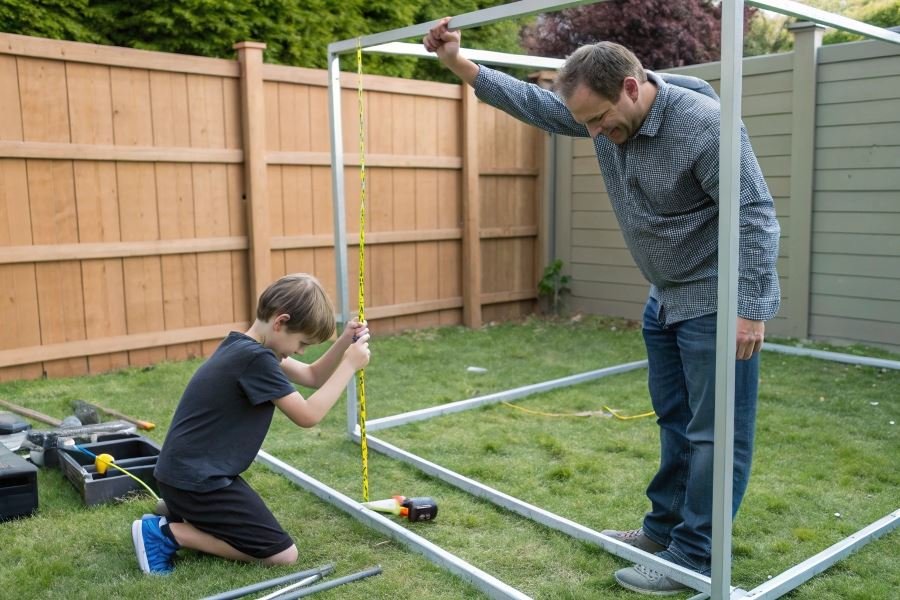
Ever watched your kids kick a ball between two sweaters on the lawn and thought, “There must be a better way”? You’re right. The difference between makeshift markers and proper football goals isn’t just aesthetic—it’s the difference between casual kicks and developing genuine skills while creating lasting family memories.
When selecting football goals for your summer house, you’re not just buying sports equipment; you’re investing in countless hours of active entertainment, friendly competition, and skill development. The right goals transform ordinary backyard sessions into mini-tournaments that everyone remembers.
Three key considerations should guide your decision:
- Space availability – Your garden dimensions will determine appropriate goal size
- Durability requirements – Will they face harsh weather or need seasonal storage?
- User profiles – Are they primarily for children’s play or adult competition?
“The quality of practice determines the quality of play.” – Football coaches everywhere
Proper goals provide structure to recreational play, allowing for targeted practice of shooting, goalkeeping, and passing accuracy. For children especially, consistently aiming at regulation-sized targets develops muscle memory that translates to improved performance on actual playing fields.
Beyond skill development, quality football goals create a natural gathering point for family and friends. They transform your summer house from a simple getaway into a recreational hub where memories are made through healthy competition and shared achievements.
Essential Factors for Choosing Football Goals
When setting up a backyard pitch, selecting the right football goals transforms casual kickabouts into memorable matches. The perfect goal setup enhances gameplay while complementing your outdoor space. Let’s dive into what truly matters when evaluating your options.
Size and Space Requirements
Your available space dictates which goal size makes sense for your summer house setup. Standard full-size goals (24’ × 8’) require substantial yard space—at least 40’ × 30’ per goal plus adequate playing area. For most residential properties, smaller options prove more practical.
How to choose football goals for a summer house often begins with measuring your available space and considering who’ll be using them. Youth-sized goals (12’ × 6’ or 9’ × 4.5’) offer excellent playability while fitting comfortably in modest yards. For truly compact spaces, consider mini goals (6’ × 4’ or smaller) that still deliver authentic gameplay without dominating your outdoor area.
Space-saving tip: Allow at least 10 feet of clearance behind goals to prevent balls from damaging property and give goalkeepers room to maneuver safely.
Material Durability and Weather Resistance
| Material | Weather Resistance | Lifespan | Best For |
|---|---|---|---|
| Aluminum | Excellent | 10+ years | Permanent installation |
| Steel | Good (with proper coating) | 5-8 years | Semi-permanent use |
| uPVC | Moderate | 3-5 years | Seasonal setup |
| Plastic | Fair | 1-3 years | Occasional use |
The material of your football goals determines their longevity and maintenance requirements. Aluminum frames offer the perfect balance—lightweight yet incredibly durable against elements. They won’t rust like steel alternatives and withstand UV exposure better than plastic options.
For goals that will face year-round weather exposure, powder-coated aluminum or galvanized steel provides superior protection. The netting material matters too—UV-treated polyethylene offers the best combination of durability and weather resistance for outdoor use.
Remember that even the most weather-resistant goals benefit from seasonal maintenance—a quick inspection and tightening of connections can add years to their lifespan.
Portability vs. Permanent Installation
Your usage pattern should determine whether portable or permanent goals make more sense:
Permanent Installation Benefits:
- Maximum stability during intense play
- Professional feel and appearance
- No setup/takedown time
- Higher durability against wind and weather
Portable Goal Advantages:
- Lawn maintenance flexibility
- Seasonal storage options
- Reconfigurable yard space
- Easier replacement/upgrades
For the perfect middle ground, consider weighted portable goals from brands like Kwik Goal or GOLME. These feature sandbag anchoring systems or internal ballast options that provide stability without permanent installation.
Foldable goals have revolutionized the portable category, offering full-sized play with remarkably compact storage. Some models collapse to just 15% of their assembled size—perfect for storing during winter months or when entertaining guests who might not share your football enthusiasm.
The ideal choice balances your space constraints, usage frequency, and aesthetic preferences. Whatever you select, proper anchoring is non-negotiable for safety, whether using ground stakes for portable options or concrete footings for permanent installations.
Making the Final Call on Your Summer House Football Goals
Finding the Sweet Spot Between Quality and Budget
Let’s face it—choosing football goals for your summer house isn’t just about grabbing the first pair you see online. It’s about making a calculated decision that balances durability, functionality, and your wallet. The perfect football goals should withstand everything from your teenager’s power shots to those competitive weekend matches with friends.
When weighing quality against budget, remember that ultra-cheap options often become expensive mistakes. A $50 set might seem attractive initially but could warp after one rainy season. Meanwhile, professional-grade aluminum goals at $800+ might be overkill for casual backyard play.
The true value of football goals isn’t in their price tag but in how perfectly they match your specific playing environment and intensity level.
Consider your usage patterns honestly. Will these goals see daily action from aspiring young players, or just occasional weekend use? For high-frequency use, investing in mid-range metal goals (200 − 400)typicallyoffersthebestlong − termvalue, whileoccasionalplayersmightfinddurableplasticorfiberglassoptions(100-250) perfectly adequate.
Top 3 Football Goal Types for Summer Houses
After analyzing hundreds of options and real-world performance, these three types consistently deliver the best experience for summer house settings:
1. Foldable Metal Goals with Ground Stakes
These combine stability with convenience, allowing you to reclaim your lawn when not in use. The metal construction handles powerful shots while ground stakes prevent tipping during intense play.
2. Weighted Base Portable Goals
Perfect for multi-use yards, these goals use sand or water-filled bases instead of permanent installation. They offer excellent stability without damaging your lawn and can be repositioned easily.
3. Premium HDPE Goals with UV Protection
These lightweight yet durable goals resist sun damage—crucial for summer house setups where equipment stays outdoors. The high-density polyethylene construction withstands impacts while remaining light enough to move single-handedly.
| Goal Type | Best For | Price Range | Weight | Setup Time |
|---|---|---|---|---|
| Foldable Metal | Serious players | $180-350 | 15-25 lbs | 5-10 mins |
| Weighted Base | Multi-use yards | $150-300 | 20-40 lbs | 10-15 mins |
| HDPE w/UV Protection | Hot climates | $120-250 | 8-15 lbs | 3-5 mins |
Extending Your Goals’ Lifespan
Even the best football goals deteriorate prematurely without proper care. Implement these maintenance practices to maximize your investment:
-
Seasonal Protection – Apply anti-rust spray to metal components before winter storage. For plastic parts, a UV-protective spray prevents brittleness from sun exposure.
-
Tension Management – Check net tension monthly. Overtightened nets strain the frame, while loose nets get damaged more easily during play.
-
Strategic Storage – When not in use for extended periods, disassemble and store in a dry place. If that’s impractical, invest in weather-resistant covers designed specifically for football goals.
-
Connection Inspection – Regularly check all connection points, especially after intense games. Loose bolts or connectors are the primary failure points in most goal systems.
-
Surface Protection – Place rubber pads under frame contact points to prevent damage to your lawn and reduce moisture-related corrosion.
By balancing your specific needs with these recommendations, you’ll select football goals that transform your summer house into the neighborhood’s premier football destination—without breaking the bank or requiring constant replacement.
